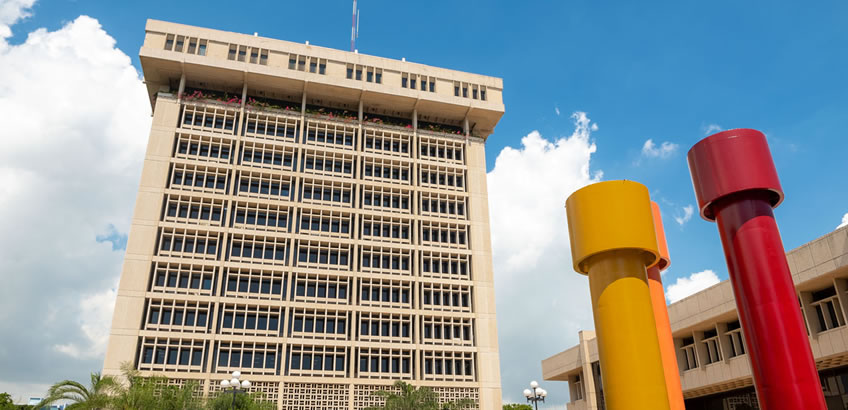Santo Domingo – The Central Bank of the Dominican Republic (BCRD), at its monetary policy meeting in March 2022, decided to increase its monetary policy interest rate by 50 basis points, from 5.00% to 5.50% per year.
The decision, according to the issuer in a press release, is based on an exhaustive evaluation of the behavior of the world economy, the greater persistence of inflationary pressures and the increase in international uncertainty derived from recent geopolitical conflicts.

He explained that price dynamics continue to be affected by external shocks that are more permanent than expected, associated with the notable increase in oil prices and other important raw materials for local production, as well as the high costs of international container transport and other disruptions in supply chains.
In particular, the monthly variation of the consumer price index (CPI) in February 2022 was 0.92%; while year-on-year inflation, that is, in the last 12 months, stood at 8.98%.
On the other hand, year-on-year core inflation, which excludes the most volatile components of the basket, stood at 6.97% in February, reflecting second-round effects on production associated with external supply shocks.
Regarding the interest rate corridor, the rate of the permanent liquidity expansion facility (1-day Repos) increases from 5.50% to 6.00% per year and the rate of interest-bearing deposits (Overnight) from 4.50% to 5.00% per year.
The BCRD’s forecasting system indicates that, in an active monetary policy scenario, inflation would gradually converge to the target range of 4% ± 1% during the monetary policy horizon, but at a slower pace than expected.
“It is important to highlight that, in addition to the monetary normalization policies, the fiscal measures that are being implemented to mitigate the increase in the prices of raw materials and the stability observed in the foreign exchange market are elements that would facilitate the convergence of inflation. to the goal,” he said.
In this scenario, the Central Bank continues to implement measures to counter external shocks on prices and contribute to the convergence of inflation to the target range, in a context of high economic dynamism.
Done since November 2021
In particular, with this decision in March, the BCRD has increased its monetary policy rate by 250 basis points since November 2021, in line with the cycle of increases in interest rates at the international level.
In a complementary manner, the BCRD has significantly reduced the excess liquidity of the financial system, through open market operations and the gradual return of the resources that had been granted during the pandemic.
These measures have succeeded in accelerating the monetary policy transmission mechanism, contributing to the adjustment of domestic interest rates and a significant moderation in the growth of monetary aggregates.
In addition, the Central Bank, as stated, is prepared to take additional measures, if necessary, to preserve price stability and keep the expectations of economic agents anchored.
In the international environment, uncertainty has increased significantly due to Russia’s invasion of Ukraine. In this context, the forecasts of Consensus Forecasts for world growth during this year they continue to be revised downwards, until placing it at 3.8%.
In the United States of America, our main trading partner, growth prospects for this year have moderated, projecting an expansion of 3.3% according to consensus and 2.8% according to the Federal Reserve (Fed). On the other hand, year-on-year inflation in that country reached 7.9% in February, its highest level in the last four decades and almost four times above its 2.0% target.
In this context, the Fed increased the federal funds rate by 25 basis points, placing it in the 0.25% – 0.50% annual range, with additional increases expected for the rest of the year. In addition, it concluded its financial asset purchase program with the aim of normalizing liquidity conditions and dealing with inflationary pressures, consistent with the actions of the other central banks.
Growth estimates for the Euro Zone have also been revised downwards, with an expected expansion of 3.2% in 2022 according to consensuswhile year-on-year inflation stood at 5.9% in February, the highest in the history of this bloc of countries.
Although the overnight deposit rate remains at -0.50% per year, the European Central Bank (ECB) ended the financial asset purchase program due to the pandemic.
regional look
For Latin America, the perspectives point to a more moderate expansion this year, estimating growth of 2.0%, according to consensus.
Given the high inflationary pressures, almost all central banks in the region have continued to increase their reference rates since 2021, as is the case of Brazil (975 basis points), Argentina (650 basis points), Chile (650 basis points ), Paraguay (550 basis points), Peru (375 basis points), Colombia (325 basis points), Uruguay (275 basis points), Mexico (225 basis points), and Costa Rica (175 basis points).
In relation to raw materials, the price of a barrel of Texas Intermediate Oil (WTI) has registered significant increases in recent months, going from an average of US$83 during January 2022 to trading around US$109 per barrel during March, reflecting the most convulsive international scenario and the limitations in world crude oil production.
Similarly, the international prices of primary food goods, such as corn, wheat and soybeans, have increased again in recent months due to the armed conflict. Meanwhile, the price of gold has increased to around US$2,000 per troy ounce, as it is used as a store of value in a scenario of greater uncertainty.
In the domestic environment, the process of recovery of aggregate demand has taken hold, highlighting the growth of the real Gross Domestic Product (GDP) during the year 2021 of 12.3%, equivalent to an expansion of 4.7% in relation to the year 2019, prior to the pandemic.
The good performance of the Dominican economy has been maintained during this year, registering an expansion of the Monthly Index of Economic Activity (IMAE) of 6.3% in January and 5.8% in February, for an accumulated growth of 6.0% during the first two months of 2022.
Going forward, the growth prospects for the Dominican economy have become more conservative due to the high uncertainty prevailing in the international environment.
Additionally, it should be taken into account that the variation rates of the IMAE for the coming months could be more moderate than those registered at the beginning of this year, influenced by the statistical effect of the comparison base, particularly in the months of March, April , and May, which were the months with the highest growth in the past year, of the order of 10.6%, 47.1% and 21.2%, respectively.
In a scenario where the risks derived from the geopolitical confrontation remain limited, the forecast models of this institution indicate that growth for this year would be around 5.0%, close to its potential, as contemplated in the most recent review. of the Monetary Program.
On the other hand, credit to the private sector in national currency maintains its dynamism, expanding year-on-year above 12% in the month of March.
The tax part
Regarding fiscal policy, the higher collections stand out in relation to what was estimated, which have provided the necessary space for the reactivation of capital spending and to apply measures aimed at mitigating the impact of higher international prices of raw materials on national production and households, especially the most vulnerable.
In the external sector, the dynamism of exports and tourism continues; as well as remittances that exceeded US$1,500 million during the first two months of the year. In this sense, the updated projections point to a Current Account deficit of around 3.0% of GDP for this year, taking into consideration that the higher exports of gold and nickel, as well as the continuous recovery of tourism, would partially offset the impact of higher oil prices.
“Additionally, it is important to highlight that Foreign Direct Investment is projected to be around US$3.4 billion, which would cover the estimated deficit for the Current Account,” the Central Bank indicated in its document.
Likewise, international reserves remain at historically high levels, around US$14.4 billion, equivalent to 14.5% of GDP and 7.1 months of imports, exceeding the metrics recommended by the IMF.
These factors have favored the relative stability of the exchange rate, reflected in a year-on-year appreciation of the local currency of around 3.5% at the end of March, which would help offset inflationary pressures from abroad.
It is important to highlight that the Dominican economy is in a good position to mitigate this adverse shock, taking into account the strength of the macroeconomic fundamentals, the good performance of domestic demand and the high levels of international reserves.
The Central Bank of the Dominican Republic reaffirms its commitment to conduct monetary policy towards the achievement of its inflation target and the proper functioning of the financial and payment systems, for which it will continue to monitor the international situation and inflationary pressures. , with the purpose of adopting additional measures in the face of factors that may put price stability at risk.

















